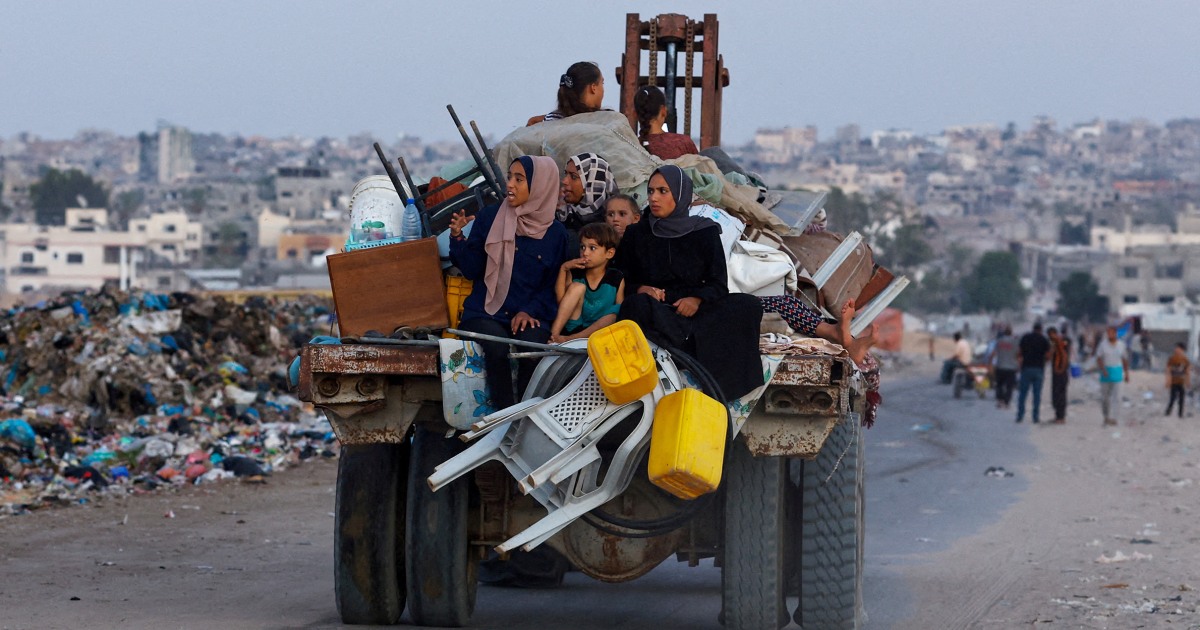Hamas’ government media office said the IDF was “deliberately suffocating” Palestinians in “narrow, inhumane areas” that are “not prepared for human life.”
Louise Wateridge, a spokesperson for UNRWA, the UN agency for Palestinian aid, said these orders are changing “almost by the hour,” and that people were leaving behind toothbrushes and shoelaces as they fled newly-declared conflict zones.
“Sometimes the military action that follows has been within 30 minutes of the order given,” she told NBC News. “There’s a lot of confusion and panic.”
The IDF did not respond to a request for comment on the limited time people have to respond to evacuation orders, as well as the impact of crowded conditions on basic services, sanitation and the spread of disease.
The U.N. says evacuation orders given since the current conflict began have displaced 90% of Gaza’s residents, often multiple times.
Doaa Qeita, a mother of three children, told NBC News that her family had been moved “at least seven times” since the beginning of the war. She said they had moved from Gaza City, to Khan Younis, to Rafah, and back to Khan Younis.
Two weeks ago, they received another order to leave.
“She was born on January 10,” Qeita says of her seven-month-old baby. “This is the seventh time she has been displaced in seven months.”
The IDF issued a new evacuation order for Palestinians in Khan Younis last week, as well as eastern Deir Al Balah, an area it had not invaded before. According to a statement issued last week, the IDF said it distributed flyers in both areas, explaining that they had become dangerous “due to significant acts of terrorism,” adding that militants had regularly been firing rockets from Khan Younis.
Ever-blurrier lines between safe zones and conflict zones have led to casualties.
Last week, at least seven people, including two children and five women, were killed after an Israeli tank strike on the Bani Suhaila district of Khan Younis, according to Gaza’s Civil Defense, the agency that provides emergency services in the enclave.
Eyewitness Ahamed Samour said he and others believed they had been in a safe zone as families ate lunch together. He went on to say that “there isn’t any ‘safe zone’ so far in the entirety of Gaza.”
Another UNWRA spokesperson, Adnan Abu Hasna, said the displaced were being treated like “chess stones,” and that congested safe zones were witnessing diseases such as hepatitis C spreading widely across the population.
The U.N said that a 10-month-old baby has been partially paralyzed after contracting polio, which had been largely eradicated in Gaza for 25 years, but is now in danger of surging due to the dire sanitation crisis. Last week, U.N. Secretary-General António Guterres said that hundreds of thousands of children in Gaza are at risk of contracting polio.
On a phone call on Wednesday with Israeli Prime Minister Benjamin Netanyahu, President Joe Biden stressed the urgency of reaching a cease-fire and hostage release deal. He also spoke with the leaders of Qatar and Egypt as negotiators seeking a cease-fire deal met in Cairo.
An Israeli official told NBC News that Israeli diplomats will head to Cairo for further talks despite intensifed fighting over the Lebanese-Israeli border Sunday between Israel and Hezbollah, and concerns that the latest regional escalation could stifle an elusive deal. Hezbollah is an ally of Hamas, both of whom are backed by Iran.
H.A. Hellyer, a scholar at the Carnegie Endowment for International Peace, a think tank in Washington D.C., believes the cease-fire negotiations were “already in pieces” before the latest round of strikes.
“I don’t think those negotiations were really going anywhere anyway,” he told NBC News.
Israel’s monthslong assault on the enclave has killed more than 40,000 people and injured 90,000, according to local health officials, which does not distinguish between combatants and civilians. The offensive was launched in the wake of the Oct. 7 Hamas attack, in which some 1,200 people, 790 of them civilians, were killed and about 250 taken hostage, according to Israeli officials.

